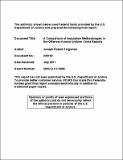|
Reseña:
|
The purpose of this study was to reexamine and recode missing data in the Uniform Crime Reports (UCR) for the years 1977-2000 for all police agencies in the United States. With the newly cleaned dataset, a clearer picture of the UCR error structure would emerge and patterns of missing data could more accurately be described. The study found that there are more missing data than identified by the FBI’s quality control. One of the most widely used and important sources of crime data for criminologists and criminal justice policy stakeholders is the Offenses-Known UCR. However, it comes with many limitations, including missing data from non-compliant police agencies. The missing data are adjusted for by imputing data based on a cross-sectional methodology to maintain comparable trending analysis. The next phase of the project was to create a dataset with only full reporting agencies for a 10 year period, which would be used to test the cross-sectional method against a longitudinal method. This was done by creating simulation data sets that “punched out” the real crime values, thus artificially creating missing data. Each imputation method could then be tested by comparing the imputed value to the actual value. The overall results showed that in most circumstances, the longitudinal method was more accurate at estimating the missing crime data points. |

